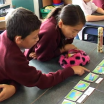Present information in different ways
Present information to year 9-13 students in different ways to encourage access and understanding.
On this page:
On this page:
Current page section: Present information in different ways
Go to top of current page: Present information in different ways
Go to top of current page: Present information in different ways
Go to top of current page: Present information in different ways
Promote understanding of spoken language
Promote understanding of spoken language
Help students with speech, language and communication needs to understand spoken content and follow verbal instructions.
To support understanding:
- use fewer words or signs
- speak or sign more slowly
- give students more time to process what they hear and see
- use supporting gestures, visuals and symbols when possible
- connect new vocabulary to familiar vocabulary
- teach and support understanding of new terms, and provide simple child-friendly definitions
- communicate using the student’s primary communication system whenever possible. For example, use AAC, point to select, coreboard symbols or NZSL
- make connections to, or use, languages spoken at home.
Give instructions in close proximity
Give instructions in close proximity
Communicate closely but take into account appropriate personal space for each unique student.
Targetted communication can help reduce distractions and support attention.

Source: Ministry of Education | Te Tāhuhu o te Mātauranga
Take a multi-sensory approach
Take a multi-sensory approach
- Offer real experiences.
- Use images, audio and video to support text and spoken information.
- Use physical or online manipulatives and tools to support tasks. For example number lines, base ten blocks, counters and scales.
- Use closed captions on videos.
- Use online simulations when possible, for example, online experiments.
- Offer digital text alongside printed versions so students can personalise it by enlarging it, listening to it, or changing the font, colours and filters.
- Make instructions, demonstrations, or key content rewindable and accessible 24/7 using screencasts, recordings, images and videos.
- Put content in a variety of formats in one place, for example, a video, a graphic and text document, by using online tools and digital platforms.
Support understanding with visuals
Support understanding with visuals
Offer information in more than one way.
Use symbols and graphics to illustrate key concepts.
Keep the layout clean and uncluttered.

Source: CORE Education
Offer text-to-speech and digital tools
Offer text-to-speech and digital tools
Offer text-to-speech tools to read text aloud and support comprehension. Wellington High School’s Ben Britton talks about how technology is used to support inclusion.
Use technologies
Use technologies
Use classroom and assistive technologies to enable learning.
Technologies can:
- provide language and visual support that can be revisited as often as required
- allow information to be presented in multisensory ways and adapted to individual needs, supporting independence
- provide a combination of visual and auditory stimuli
- provide closed captions to access audio and support the development of literacy skills
- allow students to learn at their own pace and revisit content as often as they like to consolidate learning
- offer a range of differentiated content, presented flexibly to meet individual learning requirements.
Next steps
More suggestions for implementing the strategy “Helpful classroom strategies years 9-13”:
-
Current page Present information in different ways
Return to the guide “Speech, Language and Communication”

Speech, Language and Communication
How to use this site
Guide to Index of the guide: Speech, Language and Communication
Strategies for action:
-
Identify needs and how to provide supportShow suggestions for Identify needs and how to provide support
-
Key areas to supportShow suggestions for Key areas to support
-
Helpful classroom strategies years 1-8Show suggestions for Helpful classroom strategies years 1-8
-
Helpful classroom strategies years 9-13Show suggestions for Helpful classroom strategies years 9-13
- Build language-rich environments
- Support participation and build confidence
- Present information in different ways
- Support processing and planning
- Provide options to create, learn and share
